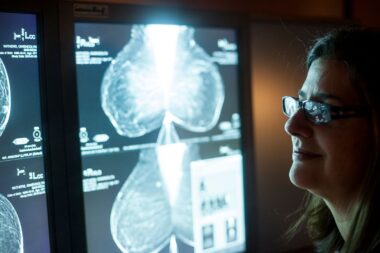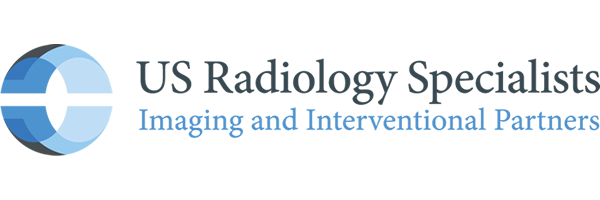As she cruised down the carpool lane on her way to work, Tara felt thankful. At 42, she was proactive about her health. She enjoyed regular hiking trips with her family, prioritized healthy eating and always made time for wellness appointments no matter how busy her schedule was. Just the day before, she had taken the time to get her annual mammogram. With no family history of breast cancer, Tara wasn’t concerned. Still, she wanted to be a positive role model for her daughters and do all she could to be there as they grew up. As she parked her car at the office, Tara’s phone rang. She held her breath and listened to the news that a small change in breast tissue had been detected in her left breast and the radiologist wanted to further evaluate it. Tara was flooded with worry but knew what she had to do — schedule a diagnostic mammogram and keep breathing.
Like Tara, feeling worried about being called back for a diagnostic mammogram is perfectly normal. Still, it’s helpful to know that for every thousand women who are recalled, approximately three will be diagnosed with breast cancer. That’s less than 1%. Chances are greater you will have a negative finding — no cancer detected. In the rare case cancer is found, early detection provides more treatment options with reduced surgery and better outcomes. In fact, clinical studies have shown that women whose breast cancer was diagnosed at stage 0 or stage 1 have a nearly 100% 5-year survival rate.
Screening Mammograms and Call Backs
Annual screening mammography is the most effective way to detect breast cancer early. 3D mammography is the most advanced technology available for breast cancer screening as validated by multiple clinical studies. At Charlotte Radiology, 3D mammograms are our standard of care for screening and diagnostic exams for all patients.
Breast health experts recommend that starting at age 40, women should schedule annual screening mammograms. These screenings can show even subtle changes in breast tissue that happen naturally and can help identify breast cancers up to two years before a lump can be felt by a physician or patient. Annual screening mammograms allow physicians to compare images year over year, helping to detect changes earlier. A radiologist subspecialized in mammography will look at the images carefully and will recommend a diagnostic mammogram if there is a concerning change in breast tissue or if another abnormality is found which requires further evaluation.
The Purpose of Diagnostic Mammograms
About 9% of women will get “called back,” or recalled following a screening mammogram so that the radiologist can obtain more detailed information from a diagnostic exam. Getting called back after a mammogram doesn’t mean you have cancer. Instead, a diagnostic mammogram may be recommended so the radiologist can further evaluate the area of concern to help better characterize it and determine next steps.
In addition to getting called back after a screening mammogram, a diagnostic mammogram may be recommended for women with a history of breast cancer or women who may be at higher risk of developing it. In this instance, diagnostic mammography serves as a supplemental screening in between annual screenings, most often at the 6–month mark.
Some of the risk factors for developing breast cancer include:
- A family history of breast or ovarian cancer
- Growing older — risk increases with age
- Dense breast tissue
- Early puberty or late menopause
- Inheriting specific genes, such as BRCA1 or BRCA2
If a woman is considered above average risk for developing breast cancer, supplemental screenings may include:
- Breast MRI or abbreviated breast MRI, an imaging test that uses magnetic fields to create a 3D image of soft tissue
- Screening breast ultrasound, an imaging test that uses sound waves to create a 3D image of the breast
Women experiencing breast symptoms may also be referred for a diagnostic mammogram by their doctor. Breast symptoms that may signal a need for a diagnostic mammogram include:
- A new lump or thickening in the armpit or breast
- Changes in breast shape or size
- Dimpling or puckering of the skin
- Newly inverted or retracted nipple
- Nipple discharge
- Skin color changes
Diagnostic mammograms require a referral from a physician. If you have risk factors or symptoms, talk with your primary care doctor to determine if a diagnostic mammogram is recommended.
What to Expect
Screening and diagnostic mammograms are conducted with the same advanced 3D mammogram technology. However, during a diagnostic mammogram, technologists may take more images to allow for a more detailed view of the breasts.
During a diagnostic mammogram, a radiologist reads the mammographic images to determine if there is a need to capture more views with 3D mammography or if additional imaging is required through another imaging modality, like breast ultrasound. For these reasons, a diagnostic mammogram appointment may take longer than a screening mammogram.
Getting the Results
After completing your diagnostic mammogram, the radiologist will meet with you to discuss your results before you leave the office. Mammogram results are calculated using the Breast Imaging Reporting and Data System (BI-RADS). BI-RADS is a reporting system used to describe the results of a mammogram, breast ultrasound or breast MRI against a standard scale. BI-RADS rates the findings on a scale of zero to six. A rating of zero means the test is inconclusive and more tests are needed. A rating of one means that the breast tissue is normal. A rating of two indicates a change was found but was negative for cancer, meaning not cancerous. As the ratings get higher, the numbers signal a greater chance that cancer may be present and therefore require a breast tissue sample for diagnosis. Depending on the results, the radiologist may recommend:
- Doing additional tests or performing a biopsy to confirm the mammogram results or get more information to help rule out cancer
- Making an appointment with an oncologist
- Returning in six months for another mammogram to monitor for further changes
3D mammography has been shown to be clinically accurate. The chances of a false result or “false positive” for breast cancer are low. The test has a positive predictive value of 86%. This means that a positive test result from a 3D mammogram is correct in more than 8 out of 10 tests. The same is true for negative results from a 3D mammogram.
Fewer than 1% of women who receive a diagnostic mammogram have breast cancer. Similarly, only about 2% of women who return for a second diagnostic mammogram in six months are found to have cancer.
If additional tests are recommended, the radiologist will let you know. They may recommend:
Your primary care doctor will also get a copy of the radiology reports in one to two business days.
Be Proactive About Breast Health
Charlotte Radiology can help you establish and maintain a proactive women’s health routine with annual screening mammograms starting at age 40. Our radiologists are subspecialized in breast imaging and procedures, and our all-female staff of technologists is focused on providing exceptional comfort and care for patients. We are here to help you stay healthy and detect breast health concerns as early as possible.



